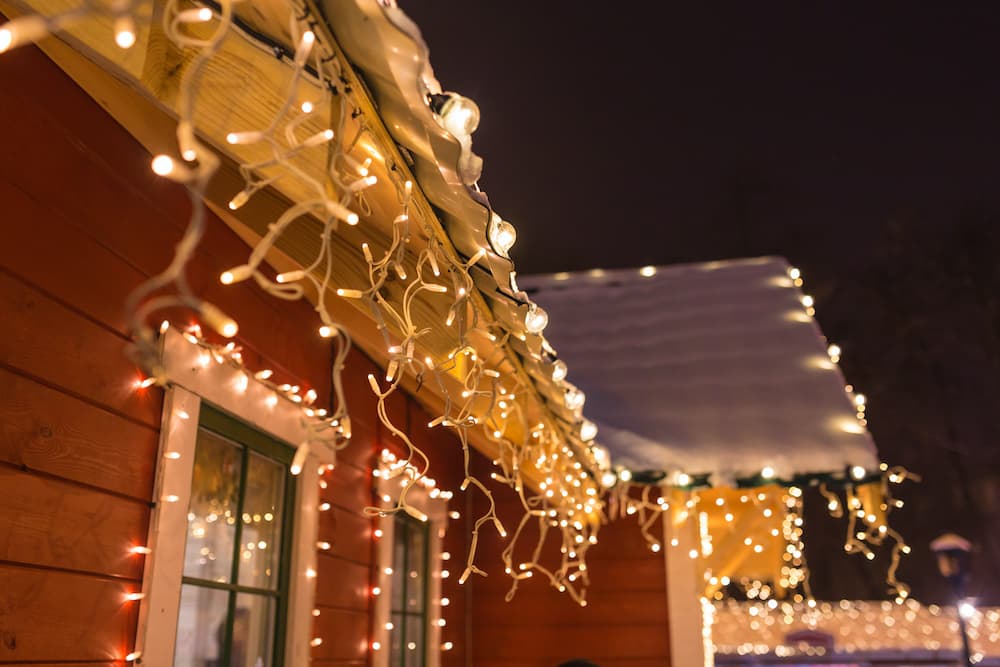Esto es lo que costarán tus luces navideñas
| Conservación y ahorro de energía, Diversión de temporada

The tradition of illuminated holiday decor stretches back to 17th-century Germany, when celebrants began affixing candles to their Christmas trees using wax or pins. Following the invention of electricity, incandescent light bulbs soon dominated the market, and the availability of inexpensive light strings made possible the elaborate outdoor light displays indigenous to North American holiday celebrations. Indoor and outdoor Christmas lights remain a fixture of the season, but all those lovely twinkling lights come with an electricity price tag. So just how much does it cost to light up your home?
Perhaps more than you think. Let’s break it down.
It’s well known that incandescent lights use far more electricity than light-emitting diode (LED) lights. There are two significant differences between incandescent and LED Christmas lights. Incandescents give off more energy as heat than they do light. This is because electricity heats up the tungsten wire in the bulb until it gives off light. LEDs, on the other hand, use solid-state chips that emit electroluminescent light, which converts almost 90% of the electricity into light and very little to heat. Since they produce minimal heat, they’re coated in clear epoxy instead of glass. Low heat and no glass mean they can last for years.
Here’s the rundown on LED efficiency:
LEDs are much cooler than incandescent lights, reducing the risk of combustion or burnt fingers.
LEDs are made with epoxy lenses, not glass, and are much more resistant to breakage.
LEDs are more durable. The same LED string could still be in use 40 holiday seasons from now.
LEDs use less electricity. Up to 25 strings of LED Christmas lights can be connected end-to-end without overloading a wall socket.¹
The other significant difference between LEDs and incandescents is price. Incandescent lights cost less up-front partly because the technology to produce them has been around for over 100 years and the production costs are therefore extremely low. Though LEDs have been available since the 1980s, LED Christmas lights have been widely available for only a few years, and it costs more to produce them.
So which lights are less expensive — incandescents or LEDs? Let’s compare the numbers.
Incandescents:
Lifespan: 3,000 hours
Cost per 50 lights: $4.06
Cost to use (assuming 12 hours/day for 45 days at $0.10/kWh): $12.15
LEDs:
Lifespan: 75,000 hours
Cost per 50 lights: $13.20
Cost to use (assuming 12 hours/day for 45 days at $0.10/kWh): $1.728
While incandescent light sets cost less initially, you’ll pay over twice as much to power just one strand of 50 lights for a holiday season. Moreover, the shorter lifespan of incandescents means you’ll have to replace them at least every 4 – 6 years. The cost to power LEDs, on the other hand, is a small fraction of the price of the lights themselves, and they’ll continue to burn for years after your incandescents have gone dark.
Most strings of incandescents are made to last no more than 90 days or about 1500 to 2000 hours because they are designed to be disposable—which also adds the unseen costs of disposal, resource waste, and environmental damage.
While LED Christmas lights will save money on your electric bill, they are part of an evolving technology that has tried out different materials and strategies over the years. Some sets sold a few years ago may have bulbs that are already dimming. Others may use different metals in their LED contacts that cause rust to form and reduce the LED bulbs’ brightness. And still, others are bright as ever. A little research will ensure you choose the best Christmas lights on the market.
The choice about how much your Xmas lights are going to cost is yours. Do you want to save a little money now on a cheap, short-lived set that will add to the cost of this Christmas and holidays to come? Or do you want something that will save you money and add to the warmth and wonder of your family traditions for years to come?
Christmas lights are just one of the many reasons energy bills tend to increase in winter. Check out these tips to reduce the impact of cold weather on your electricity bill.
Sources: